You’re a daring adventurer who wants to explore the world’s oceans for months at a time, braving the elements and reveling in the thrill of discovery. But you’re also a person who, after reaching a certain level of success in your life, knows how to live well, just like Iron Man’s alter ego Tony Stark. After a particularly scintillating day on the water, you enjoy sharing the experience with your friends over a fine meal and a bottle of 1995 Chateau Valandraud Saint-Emilion.
That’s why you explore on a state-of-the-art expedition yacht. Whether you want to get up close and personal with great white sharks off the Great Barrier Reef or take a firsthand look at what the king crab fishing crews really go through on the TV hit “Deadliest Catch” near Dutch Harbor, Alaska, an expedition yacht— sometimes known as an explorer yacht—is the best vessel for the job. These boats are designed for long-range cruising with the accommodations and facilities you need to spend months at a time on the water. Each year, designers and yards push the limits ever further in terms of range, size, and performance. We’ve compiled a list of five of the newest boats that are either under construction or being retrofitted for extreme cruising. Some are being built by well-known yards, such as Delta Yachts, while others are new names on the scene. Read on to see the 2010 expedition boats that are pushing the limits of endurance and speed—and doing so in luxurious style.
The Newcomer
Aquos Yachts is a fairly new force, a collaborative organization of some well-known names in the design and construction segments of the industry. The company’s chairman is a Hong Kong-based businessman originally from the United Kingdom, and Project Manager David Darwent has directed the builds of the some of the most special boats in the world. The designers are Greg C. Marshall Naval Architects of Victoria, British Columbia, and construction is taking place in New Zealand at McMullen & Wing. Needless to say, Darwent has piled up some serious frequent flyer miles.
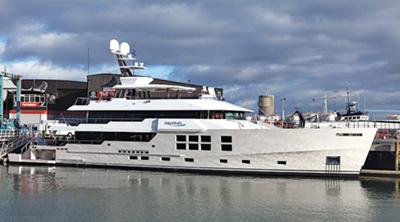
Aquos Yachts is actually developing two boats almost simultaneously, the 45-meter Big Fish and the 50-meter Star Fish, both of which are known for innovative firsts in terms of construction elements and ecological awareness. Among the firsts on the striking new boats is granite decking, which is indestructible, maintenance-free, and ecologically responsible. Because the granite requires no maintenance and the boat’s color was designed to look good—according to Aquos—even when covered in salt from spray, fewer crewmembers are required to maintain its appearance. Big Fish, which was completed in March, has extra large protected stowage in the bow for a custom 28-foot tender (it has a range of 300 nautical miles) and toys. It also has extraordinarily convenient access to the water from what Aquos calls a “transformer-style swim platform,” which retracts into the hullsides when not in use. Fold-down aft “beaches” combine to create a 37-foot platform that is ideal as a dive or research center.
Accommodations for up to 10 people and nine crew in the trideck layout include a full-beam owner’s stateroom located aft on the bridge deck. Four guest cabins can convert to two full-beam staterooms when you have guests on board who would like a little extra pampering. All cabins have an en suite head. The saloon, dining area, and galley are on the main deck. Extra-large windows (they’re too big to call them portlights) let in massive amounts of natural light, and a full-height atrium stairwell from the lower deck all the way to the flying bridge allows for easy passage.
Extensive tank testing combined with tried-and-true propulsion help give Big Fish a range of 10,000 nautical miles. The hull is steel with an aluminum superstructure. It measures 147 feet, seven inches, with a beam of 29 feet, six inches. The draft is eight feet, five inches. It’s powered by twin 1,050-horsepower Caterpillar 3508B DITA engines. Fuel tankage is 92,000 liters, and the boat has a freshwater capacity of 11,400 liters. Maximum range is achieved at 8 knots. For decreased electrical consumption, the boat features 95-percent LED lighting, which allowed the designer and builder to cut onboard generator sizes in half, compared to a similarly sized boat. Total generator capacity is 125 kilowatts. The yacht will also feature the world’s most sophisticated night navigation equipment from British Columbia-based Current Corporation. Aquos Yachts, (954) 770-9624; www.aquosyachts.com
The Veteran
While Aquos is a collaborative effort bringing together forces from around the world, Delta Yachts in Seattle is an all-inclusive effort that has expanded to offer even more services to its customers. In 2009, Delta opened Delta North, a fully enclosed steel-hull construction center that lets the company build metal hulls more than 100 meters in length. Delta also compiled a highly experienced metal-vessel construction team.
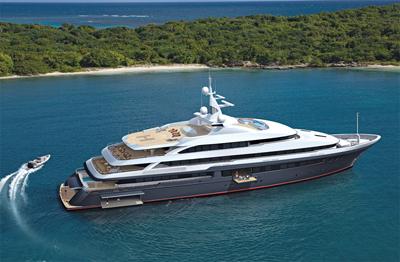
This is not to say that Delta isn’t already experienced in metalboat construction. The company built the 204-foot Laurel a few years ago and is currently working on a 180-foot aluminum hull. When each metal hull is completed, it will be transported three miles to Delta’s main site by barge for outfitting and finish work.
“This allows us to be more innovative, less restricted by history, and find unconventional solutions—lightweight, creative forms that are more progressive in design and utility,” says Jay Miner, Delta’s chief naval architect.
The first hull to be built at Delta North is a 200-foot steel and composite expedition yacht with diesel-electric propulsion and dynamic positioning. Known as Project 200040, the boat is designed to the latest in environmental standards, including a comprehensive waste management plan. It has helicopter-landing capabilities and is currently designed to include a recessed helicopter garage. With an ice-class designation, this yacht is suitable for luxury entertaining and personal exploration anywhere in the world, or even remote oceanographic research. The interior and superstructure can be custom-designed to meet the requirements of the owner. Hull construction is underway, and delivery is scheduled for 2011.
Specifications include an overall length of 208 feet with a beam of 42 feet, seven inches and a draft of 12 feet, eight inches. The boat displaces 1,550 long tons at half load. Twin Caterpillar 3512 1,700 kW propulsion generators give the vessel a top speed of 16.6 knots with a cruise of 15 knots, according to the builder. Maximum range is 7,000 miles at 12 knots. Fuel capacity is 12,300 gallons. Quantum QC-2200XT Zerospeed stabilizers tame roll, and maneuverability is enhanced by a 250 kW Schottel SST 170TLK bow thruster. Accommodations for up to 12 guests and 22 crew are provided in the trideck layout. Delta Yachts, (206) 763-2383; www.deltamarine.com
The Journeyman
Inace’s 135-foot Explorer, Veronika, combines classic yacht styling with all the equipment needed for serious exploration. For example, the fast displacement hull designed by architect John Overing has double the bow height of a typical cruising yacht, which gives Veronika improved seaworthiness in big seas.
The boat was commissioned by an owner who is moving up from a 95-foot aft-house design. He wants to be on board for extended cruises of up to three months at a time and wanted something bigger and more seaworthy. His wife still wanted a “yachty” looking boat. As the old saying goes, “Happy wife, happy life,” so this hybrid design was developed.
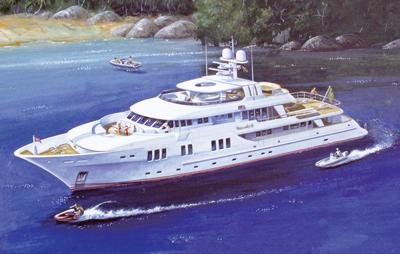
“We created a magnificent boat that incorporates the yacht look with the exploration sensibilities,” said John DeCaro, the owner of All Ocean Yachts in Fort Lauderdale, who is also the project manager for the boat. It’s scheduled to be delivered in spring 2011.
A pair of Cat continuous-duty K-rated engines, designed for low fuel consumption and good endurance, provide the propulsion. The boat carries 22,500 gallons of fuel and 3,000 gallons of fresh water, plus Veronika has an extensive watermaking system.
For a vessel of this size, the cruising speed of 16 knots is impressive, as is the 6,000-mile range. Extended range at lower speeds for maximum efficiency is 8,000 miles. “It’s a bridge between a light yacht and an explorer yacht,” explained DeCaro. Twin 22-foot tenders will take care of ferrying duty.
Veronika’s master stateroom is 780 square feet on the deck level, and there are a total of six cabins, including one that converts to a fitness center. Crew requirements call for seven people. All Ocean Yachts, (954) 671-0107; www.buyexploreryachts.com
The Russian Retrofit
Originally built in 1972 as an Ice Class Hydrographical Survey Vessel for the USSR, Olivia is now a 230-foot, steel-hull expedition yacht capable of traversing the most adverse weather conditions and equipped with state-of-the-art machinery. Additional specifications include a beam of 39 feet, with a minimum draft of just under 10 feet. The ship displaces 1,200 tons and carries 85,865 gallons of fuel plus 29,062 gallons of fresh water.
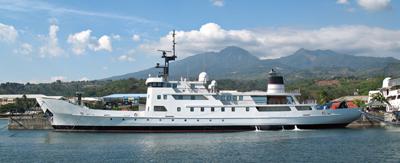
Equipment highlights include a three-ton and an eight-ton davit for lifting aboard research gear or virtually any size tender. The boat is powered by a Deutz AG RBV 6M 358 single-screw diesel engine that pushes her to 15 knots with a cruise speed of 12 knots and gives it an astounding range of 13,500 nautical miles. The propulsion system is new as part of the retrofit that recently took place. Rolls-Royce stabilizers and anti-rolling tanks provide additional comfort. For ease of navigation, all electronics have been upgraded as well.
Exterior styling and interior enhancements came from Rouvia Road Yacht Design & Construction in the Philippines, while naval architecture by OY Laivateollisuus, drafted to RINA class specifications, ensure that the boat can handle myriad conditions.
Olivia offers accommodations for up to 10 guests in five luxurious suites with crew quarters for up to 22, which guarantees that everyone aboard will be well served.
The Do-It-Yourselfer
While most buyers of large expedition yachts have quite a bit of direct input on new builds, John DeCaro and designer Luiz de Basto have taken this concept to a new level with the Inace 90 Expedition. On his website, www.buyexploreryachts.com, DeCaro posted initial plans for the boat in Summer 2009 and then solicited feedback from prospective buyers.
Following is the initial entry: “Dear All, I would like to ask you for your assistance and input into a new 90-foot design that we are developing with Luiz de Basto Design. It is All Ocean Yacht’s new Raised Foredeck Explorer.”
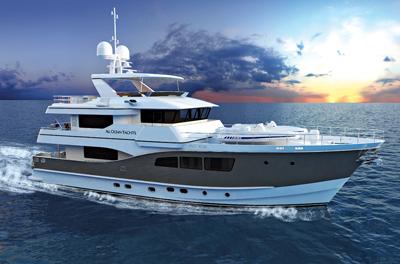
The vessel’s basic design has a master on the main deck, four guest cabins below, each with an en suite head, and two crew cabins, each with its own en suite head, for four crew. The 90 RFD (Raised Foredeck Design) will be built as a series and as a semi-production model with elements of various layouts that can be interchanged. The World Cruise Layout provides the greatest separation between guest and crew, thanks to dedicated crew stairs to the wheelhouse. There are two-crew cabins below with en suite heads, as well as a crew settee in the galley. The galley will feature a spacious work area for the chef, as well as a side-by-side refrigerator, double ovens, and a pantry. There is a second full-size refrigerator and freezer, plus a sink and dishwasher in what the designer referred to as the “stewardess” area next to the breakfast bar.
In the wheelhouse, you’ll find a settee, navigation desk, and direct access to the captain’s private stateroom.
In the Universal Layout, the second stair to the wheelhouse is removed, the laundry is moved up to the deck level, and the day-head is now in the main foyer, creating a separation between the crew galley and the service entrance. The crew can exit the galley and proceed directly up the stairs to the pilothouse without having to enter the guest area.
In this layout, the skylounge increases in size and has a full-size bar. The wheelhouse settee is expanded and can be used as a daybed during long passages in poor weather conditions.
Common features of both designs include the large master stateroom on the main deck that spans the full 24-foot beam. The large head has twin sinks, a shower, and a separate toilet room with space for a bidet. The lower-deck guest area consists of four guest staterooms with their own stairway. There are two twin guest staterooms with large en suite heads and, forward of those, two queen staterooms. If there are fewer than eight guests aboard, one stateroom could be converted to an office, a gym, or a classroom.
The dining area could be either a full table with chairs or a combination banquette and chairs, while the main saloon has a comfortable area large enough for all the guests to sit and converse or watch the retractable TV. The afterdeck has a lounging area with a full wet bar, or you can ascend the stairs to the flying bridge, which has a full-size Jacuzzi with raised sunpads, another bar, a barbecue, and lounge area. All Ocean Yachts, (954) 671-0107; www.buyexploreryachts.com
With the exception of Veronika, many of the boats featured in this story are available for charter or will be when they’re completed. That means you can choose any of them and set off on the adventure of a lifetime.









